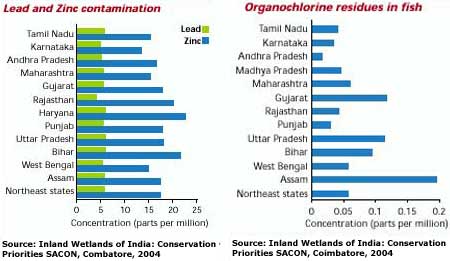Drained India`s inland wetlands
 • The Salim Ali Centre for Ornithology and Natural History (sacon) in Coimbatore collected about 1,700 fish samples representing 66 species from 173 wetlands in 14 states. Of them, 1,600 samples were analysed for residues of pesticides including ddt and its metabolites, various isomers of hexachlorocyclohexane (hch), heptachlor and heptachlor epoxide, dieldrin and endosulfan and its metabolites. Every single fish sample analysed was found contaminated with one or more pesticides.
• The Salim Ali Centre for Ornithology and Natural History (sacon) in Coimbatore collected about 1,700 fish samples representing 66 species from 173 wetlands in 14 states. Of them, 1,600 samples were analysed for residues of pesticides including ddt and its metabolites, various isomers of hexachlorocyclohexane (hch), heptachlor and heptachlor epoxide, dieldrin and endosulfan and its metabolites. Every single fish sample analysed was found contaminated with one or more pesticides.
• The most commonly found pesticide was hch. Together with its isomers, hch was detected in 80 per cent of the fish samples, including those from relatively remote regions. Heptachlor epoxide was detected in 78 per cent, endosulfan in 66 per cent and ddt and its metabolites in 76 per cent of the samples tested.
• The fish of Son beel (wetland) of Assam, Meshwo dam of Gujarat, Ambazari lake of Maharashtra, Khatima wetland in Uttar Pradesh and Gojoldaba barrage of West Bengal had pesticide residues exceeding the limits recommended for human consumption by various statutory agencies including the World Health Organization (who).
• The fish species with a high pesticide residue include Puntius dorsalis (long-snouted barb), Puntius sophore (pool barb or punti), Xenotodon cancilla (freshwater needlefish) and Heteropneustes fossilis (Indian stinging catfish or singhi). Residues of organochlorine pesticides were the highest in the fish from Assam and lowest in those from Andhra Pradesh.
• 'If a person in Assam, Bihar, Gujarat and Maharashtra consumes even as little as 250 grammes of these fish species per week, he/she will exceed the acceptable daily intake (adi) for hch. For Uttar Pradesh, a person consuming a similar quantity will exceed the adi for both hch and endosulfan,' says S Muralidharan, the head of the team that analysed the samples.
• Puntius sophore is to be viewed with great concern, especially in Tamil Nadu, where it is considered to possess medicinal values. It is also common in the ponds of West Bengal.
• Among the three north eastern states of Nagaland, Manipur and Meghalaya, Nagaland detected the maximum load of residues of organochlorine pesticides (0.16 parts per million, or ppm). Their level in Loktak lake in Manipur (a Ramsar Convention on Wetlands site) and Umiam lake in Meghalaya were 0.558 ppm and 0.038 ppm respectively.
• All the 1,694 fish samples analysed for copper, lead, zinc, cadmium and chromium residues were found to contain at least one of them. "The results have shocked us also. I have stopped eating fish since the time I saw these results,' says sacon director V S Vijayan.
• Of all the heavy metals analysed, lead was the most prevalent contaminant followed by zinc. Wetlands of Uttar Pradesh, Bihar and Haryana were the most contaminated.
• The levels of lead in many fish species are within the who limits suggested for human consumption. But regular consumption of even these fish may cause renal and hepatic failures.
• In the north east, the Loktak and Umiam lakes had a high concentration of these metals, which could be a reason for their fish yield declining by half.
• sacon has suggested a national wetland conservation and sustainable use action plan till 2020. Measures suggested include a complete ban on conversion of wetland of 0.5 hectare and above in size into any other land use, constituting empowered people's committees to prevent dumping of waste and polluting of the wetlands and some provision to ban the use of pesticides in their vicinity.
• Experts warn that such measures have been proposed earlier, too, but not implemented properly. If any remedial steps are not taken soon, we will hardly have any wetlands left. Even the ones that will remain will be too contaminated to nurture any kind of biodiversity.
